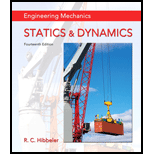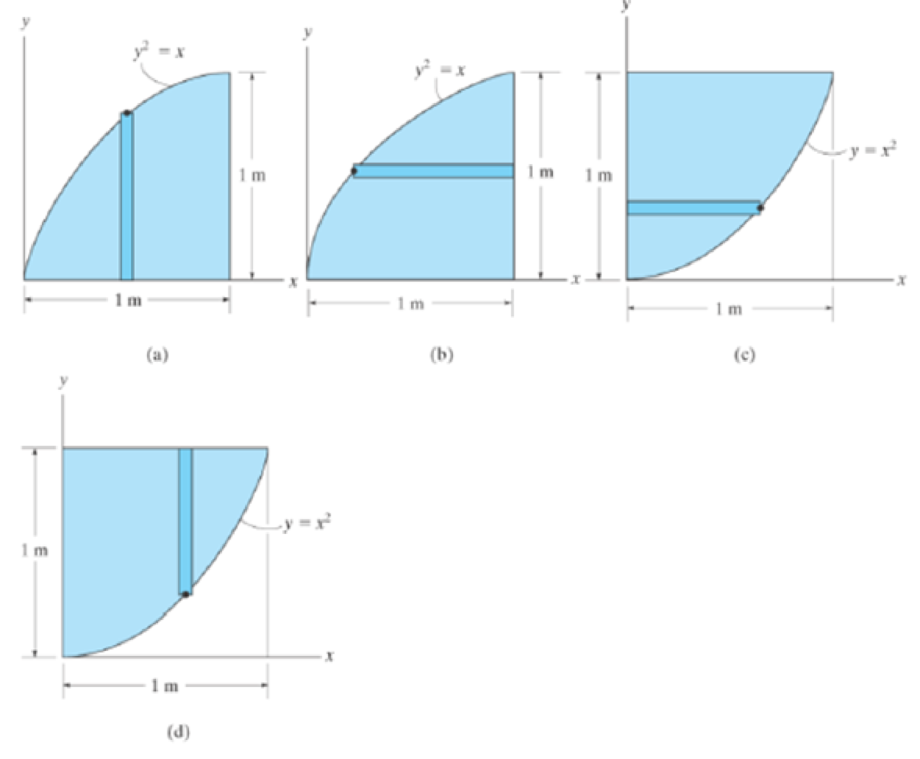
Engineering Mechanics: Statics & Dynamics (14th Edition)
14th Edition
ISBN: 9780133915426
Author: Russell C. Hibbeler
Publisher: PEARSON
expand_more
expand_more
format_list_bulleted
Concept explainers
Textbook Question
Chapter 9.1, Problem 1PP
In each case, use the element shown and specify

Prob. P9-1
Expert Solution & Answer
Want to see the full answer?
Check out a sample textbook solution
Students have asked these similar questions
using the theorem of three moments, find all the moments, I need concise calculations only
Practise question need help on
Can you show explaination and working. The answer from the text book is Q=5.03 X 10^-3
Chapter 9 Solutions
Engineering Mechanics: Statics & Dynamics (14th Edition)
Ch. 9.1 - In each case, use the element shown and specify...Ch. 9.1 - Determine the centroid (x,y) of the shaded area....Ch. 9.1 - Determine the centroid (x,y) of the shaded area....Ch. 9.1 - Determine the centroid of the shaded area. Prob....Ch. 9.1 - Locate the center of mass x of the straight rod if...Ch. 9.1 - Locate the centroid of the homogeneous solid...Ch. 9.1 - Locate the centroid z of the homogeneous solid...Ch. 9.1 - Locate the center of mass of the homogeneous rod...Ch. 9.1 - Prob. 2PCh. 9.1 - Locate the center of gravity x of the homogeneous...
Ch. 9.1 - Locate the center of gravity of the homogeneous...Ch. 9.1 - Prob. 5PCh. 9.1 - Locate the centroid of the area.Ch. 9.1 - Locate the centroid x of the parabolic area. Prob....Ch. 9.1 - Prob. 8PCh. 9.1 - Locate the centroid x of the shaded area. Probs....Ch. 9.1 - Locate the centroid of the shaded area. Probs....Ch. 9.1 - Locate the centroid x of the area. Probs. 9-11/12Ch. 9.1 - Locate the centroid of the area. Probs. 9-11/12Ch. 9.1 - Locate the centroid x of the area. Probs. 9-13/14Ch. 9.1 - Locate the centroid of the area. Probs. 9-13/14Ch. 9.1 - Prob. 15PCh. 9.1 - Prob. 16PCh. 9.1 - Prob. 17PCh. 9.1 - Prob. 18PCh. 9.1 - Prob. 19PCh. 9.1 - Prob. 20PCh. 9.1 - Locate the centroid x of the shaded area. Probs....Ch. 9.1 - Locate the centroid of the shaded area. Probs....Ch. 9.1 - Prob. 23PCh. 9.1 - Locate the centroid of the shaded area. Probs....Ch. 9.1 - Prob. 25PCh. 9.1 - Locate the centroid x of the shaded area. Probs....Ch. 9.1 - Locate the centroid of the shaded area. Probs....Ch. 9.1 - Prob. 28PCh. 9.1 - Prob. 29PCh. 9.1 - Locate the centroid x of the shaded area. Probs....Ch. 9.1 - Prob. 31PCh. 9.1 - Prob. 32PCh. 9.1 - Prob. 33PCh. 9.1 - The steel plate is 0.3 m thick and has a density...Ch. 9.1 - Prob. 35PCh. 9.1 - Prob. 36PCh. 9.1 - Prob. 37PCh. 9.1 - Determine the location r of the centroid C for the...Ch. 9.1 - Locate the center of gravity of the volume. The...Ch. 9.1 - Prob. 40PCh. 9.1 - Locate the centroid z of the frustum of the...Ch. 9.1 - Prob. 42PCh. 9.1 - Locate the centroid of the quarter-cone. Prob....Ch. 9.1 - Prob. 44PCh. 9.1 - Locate the centroid z of the volume. Prob. 9-45Ch. 9.1 - Prob. 46PCh. 9.1 - Prob. 47PCh. 9.1 - Prob. 48PCh. 9.1 - Prob. 49PCh. 9.1 - Prob. 50PCh. 9.2 - Locate the centroid (x,y,z) of the wire bent in...Ch. 9.2 - Prob. 8FPCh. 9.2 - Prob. 9FPCh. 9.2 - Prob. 10FPCh. 9.2 - Prob. 11FPCh. 9.2 - Prob. 12FPCh. 9.2 - Prob. 51PCh. 9.2 - Prob. 52PCh. 9.2 - Prob. 53PCh. 9.2 - Prob. 54PCh. 9.2 - Locate the centroid (x,y) of the metal cross...Ch. 9.2 - Prob. 56PCh. 9.2 - Prob. 57PCh. 9.2 - Determine the location of the centroidal axis xx...Ch. 9.2 - Locate the centroid (x,y) of the shaded area....Ch. 9.2 - Prob. 60PCh. 9.2 - Determine the location of the centroid C of the...Ch. 9.2 - Locate the centroid (x,y) of the shaded area....Ch. 9.2 - Determine the location of the centroid of the...Ch. 9.2 - Locate the centroid (x,y) of the shaded area....Ch. 9.2 - Determine the location (x,y) of the centroid C of...Ch. 9.2 - Determine the location of the centroid C for a...Ch. 9.2 - Locate the centroid of the cross-sectional area...Ch. 9.2 - A triangular plate made of homogeneous material...Ch. 9.2 - A triangular plate made of homogeneous material...Ch. 9.2 - Prob. 70PCh. 9.2 - Prob. 71PCh. 9.2 - Prob. 72PCh. 9.2 - Prob. 73PCh. 9.2 - Prob. 74PCh. 9.2 - Locate the center of mass (x,y,z) of the...Ch. 9.2 - The sheet metal part has the dimensions shown....Ch. 9.2 - Prob. 77PCh. 9.2 - The wooden table is made from a square board...Ch. 9.2 - Prob. 79PCh. 9.2 - Prob. 80PCh. 9.2 - Prob. 81PCh. 9.2 - Prob. 82PCh. 9.2 - Prob. 83PCh. 9.2 - Prob. 84PCh. 9.2 - Determine the distance z to the centroid of the...Ch. 9.2 - Prob. 86PCh. 9.2 - Prob. 87PCh. 9.2 - Prob. 88PCh. 9.2 - Prob. 89PCh. 9.3 - Prob. 13FPCh. 9.3 - Prob. 14FPCh. 9.3 - Prob. 15FPCh. 9.3 - Prob. 16FPCh. 9.3 - Prob. 90PCh. 9.3 - Prob. 91PCh. 9.3 - Prob. 92PCh. 9.3 - Prob. 93PCh. 9.3 - Prob. 94PCh. 9.3 - Prob. 95PCh. 9.3 - Prob. 96PCh. 9.3 - Determine the volume of concrete needed to...Ch. 9.3 - Determine the surface area of the curb. Do not...Ch. 9.3 - Prob. 99PCh. 9.3 - Prob. 100PCh. 9.3 - Prob. 101PCh. 9.3 - Prob. 102PCh. 9.3 - Prob. 103PCh. 9.3 - Prob. 104PCh. 9.3 - Prob. 105PCh. 9.3 - Prob. 106PCh. 9.3 - Prob. 107PCh. 9.3 - Prob. 108PCh. 9.3 - Prob. 109PCh. 9.3 - Prob. 110PCh. 9.3 - Prob. 111PCh. 9.3 - Prob. 112PCh. 9.3 - Prob. 113PCh. 9.3 - Prob. 114PCh. 9.5 - Determine the magnitude of the hydrostatic force...Ch. 9.5 - Determine the magnitude of the hydrostatic force...Ch. 9.5 - Prob. 19FPCh. 9.5 - Prob. 20FPCh. 9.5 - Prob. 21FPCh. 9.5 - The pressure loading on the plate varies uniformly...Ch. 9.5 - The load over the plate varies linearly along the...Ch. 9.5 - Prob. 117PCh. 9.5 - Prob. 118PCh. 9.5 - Prob. 119PCh. 9.5 - When the tide water A subsides, the tide gate...Ch. 9.5 - The tank is filled with water to a depth of d = 4...Ch. 9.5 - Prob. 122PCh. 9.5 - The factor of safety for tipping of the concrete...Ch. 9.5 - Prob. 124PCh. 9.5 - The tank is used to store a liquid having a...Ch. 9.5 - Prob. 126PCh. 9.5 - Prob. 127PCh. 9.5 - Prob. 128PCh. 9.5 - Determine the magnitude of the resultant force...Ch. 9.5 - The semicircular drainage pipe is filled with...Ch. 9.5 - Prob. 1RPCh. 9.5 - Prob. 2RPCh. 9.5 - Prob. 3RPCh. 9.5 - Prob. 4RPCh. 9.5 - Prob. 5RPCh. 9.5 - Prob. 6RPCh. 9.5 - Prob. 7RPCh. 9.5 - Prob. 8RPCh. 9.5 - The gate AB is 8 m wide. Determine the horizontal...Ch. 9.5 - Prob. 10RP
Knowledge Booster
Learn more about
Need a deep-dive on the concept behind this application? Look no further. Learn more about this topic, mechanical-engineering and related others by exploring similar questions and additional content below.Similar questions
- practise questionarrow_forwardCan you provide steps and an explaination on how the height value to calculate the Pressure at point B is (-5-3.5) and the solution is 86.4kPa.arrow_forwardPROBLEM 3.46 The solid cylindrical rod BC of length L = 600 mm is attached to the rigid lever AB of length a = 380 mm and to the support at C. When a 500 N force P is applied at A, design specifications require that the displacement of A not exceed 25 mm when a 500 N force P is applied at A For the material indicated determine the required diameter of the rod. Aluminium: Tall = 65 MPa, G = 27 GPa. Aarrow_forward
- Find the equivalent mass of the rocker arm assembly with respect to the x coordinate. k₁ mi m2 k₁arrow_forward2. Figure below shows a U-tube manometer open at both ends and containing a column of liquid mercury of length l and specific weight y. Considering a small displacement x of the manometer meniscus from its equilibrium position (or datum), determine the equivalent spring constant associated with the restoring force. Datum Area, Aarrow_forward1. The consequences of a head-on collision of two automobiles can be studied by considering the impact of the automobile on a barrier, as shown in figure below. Construct a mathematical model (i.e., draw the diagram) by considering the masses of the automobile body, engine, transmission, and suspension and the elasticity of the bumpers, radiator, sheet metal body, driveline, and engine mounts.arrow_forward
- 3.) 15.40 – Collar B moves up at constant velocity vB = 1.5 m/s. Rod AB has length = 1.2 m. The incline is at angle = 25°. Compute an expression for the angular velocity of rod AB, ė and the velocity of end A of the rod (✓✓) as a function of v₂,1,0,0. Then compute numerical answers for ȧ & y_ with 0 = 50°.arrow_forward2.) 15.12 The assembly shown consists of the straight rod ABC which passes through and is welded to the grectangular plate DEFH. The assembly rotates about the axis AC with a constant angular velocity of 9 rad/s. Knowing that the motion when viewed from C is counterclockwise, determine the velocity and acceleration of corner F.arrow_forward500 Q3: The attachment shown in Fig.3 is made of 1040 HR. The static force is 30 kN. Specify the weldment (give the pattern, electrode number, type of weld, length of weld, and leg size). Fig. 3 All dimension in mm 30 kN 100 (10 Marks)arrow_forward
- (read image) (answer given)arrow_forwardA cylinder and a disk are used as pulleys, as shown in the figure. Using the data given in the figure, if a body of mass m = 3 kg is released from rest after falling a height h 1.5 m, find: a) The velocity of the body. b) The angular velocity of the disk. c) The number of revolutions the cylinder has made. T₁ F Rd = 0.2 m md = 2 kg T T₂1 Rc = 0.4 m mc = 5 kg ☐ m = 3 kgarrow_forward(read image) (answer given)arrow_forward
arrow_back_ios
SEE MORE QUESTIONS
arrow_forward_ios
Recommended textbooks for you
 International Edition---engineering Mechanics: St...Mechanical EngineeringISBN:9781305501607Author:Andrew Pytel And Jaan KiusalaasPublisher:CENGAGE L
International Edition---engineering Mechanics: St...Mechanical EngineeringISBN:9781305501607Author:Andrew Pytel And Jaan KiusalaasPublisher:CENGAGE L

International Edition---engineering Mechanics: St...
Mechanical Engineering
ISBN:9781305501607
Author:Andrew Pytel And Jaan Kiusalaas
Publisher:CENGAGE L
moment of inertia; Author: NCERT OFFICIAL;https://www.youtube.com/watch?v=A4KhJYrt4-s;License: Standard YouTube License, CC-BY